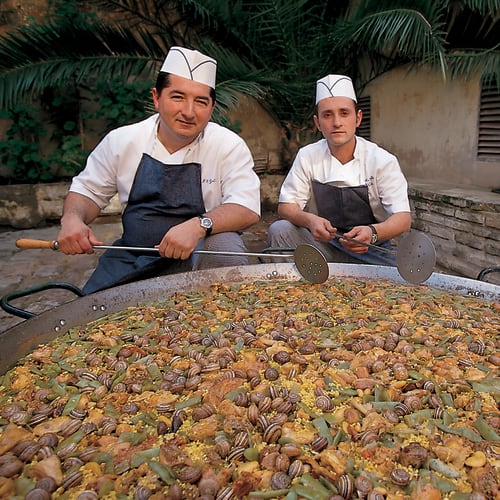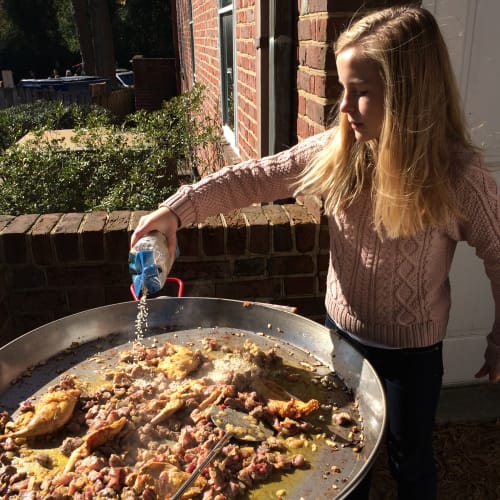The Secrets of Authentic Valencian Paella
Don Harris | June 2017




Dear Friends of La Tienda,
Valencia is the hometown of paella, the festive rice dish cooked over open fire. Many would say it is Spain’s most famous meal. During the incredible Las Fallas celebration each March, the streets are full of revelers, and just about every street corner has a stand selling an inviting pan of paella.

My first experience with Valencia was many years ago when I was a rookie chaplain on my first Mediterranean cruise. Before we stopped in Valencia, our first port of call was scheduled to be the scenic bay of Palma de Mallorca. Unfortunately, permission for the crew to go ashore was restricted, due to the behavior of a few of the crew of a submarine which had preceded us. It seems some of the sailors found the beaches a little too inviting and were spotted scampering naked across one of the hidden coves by the vigilant Guardia Civil. (I recall the recruiting slogan at the time “Sailors have more fun!”)
All this explains why our first port was Valencia. And what an exciting port it is: teeming with ships from all over the world. Many of our products at La Tienda are shipped in containers from the still vibrant port. That first visit, I loved to stroll the waterfront when I was on liberty, and I especially enjoyed meeting both students and young workers at some of the many cafés and tapas bars. It was there that I began my adventure of sampling the many flavors of Spain, including of course, paella.
Paella began as a laborer’s simple meal of rice, meats and vegetables which he prepared while working in the fields, vineyards or rice marshes. He would kindle an open fire with available sticks or even vine clippings and simmer the ingredients over an open fire. Now paella is enjoyed across Spain and throughout the world. It is a delicacy equally at home in fine restaurants or prepared on the backyard grill. The secret to paella’s allure is that it is a shared dish - a flexible combination of flavors that can be prepared and enjoyed by a group of friends or family.

As it became popular, the pure paella of Valencia morphed into a thousand variations, many of them wildly different from the original. Valencians deride most attempts as “arroz con cosas,” translated as “rice with a bunch of stuff in it,” not real paella at all. While I have suffered through some ill-conceived paellas in my time, I have also eaten some spectacular creations that did not follow all the rules. That said, before you break the rules it is important to know them! Here are some key aspects of authentic Valencian paella that all novice paella chefs should know:
1. It’s all about the rice. Valencian short grained rice (senia or bomba) absorbs flavor without breaking down or becoming mushy. When served, the rice in paella should be intact and almost “al dente.” We favor Calasparra rice grown in the mountains not too far from Valencia, irrigated with cold, fresh water supplied from ancient aqueducts. This results in an extended growing period, making the rice grain very dense and thirsty for the flavor base you are building.
2. Use real saffron from a source you can trust. This famous spice consists of the stigma of a special crocus flower, plucked by hand and toasted. Don’t use cheap alternatives, such as “colorante.” Saffron adds a beautiful aroma and subtle yellow color to your paella that you can’t do without. It is rated by the intensity of its flavor and color. You will not economize with bargain saffron, because you will have to use more in order to compensate for its deficient flavor.
3. The original Valencian paella features just the chicken or rabbit, flat green (Italian) beans and snails (if you can find them)! Some variation is accepted – such as adding mushrooms or creating a seafood version. The ingredients most offensive to paella purists are chorizo sausage, peas and onions.
4. Once you add the liquid to the rice in the paella pan, do not stir! A thin film of oil will cover the cooking rice, sealing in the liquid. If you stir, this barrier will be broken and the rice will not cook correctly.
5. Use a real paella pan. This broad flat pan distributes heat quickly and evenly, and it also cools rapidly once the heat is removed. This is critical so that you can adjust the heat quickly and so that the paella doesn’t continue to cook after it is done. Our favorite pan is the traditional carbon steel version.

Our chef recently took a trip to Valencia to learn from the masters. He studied under three chefs, including two gray-bearded brothers at the restaurant El Famos, where they still cook over an open fire of orange wood. He was surprised to learn that they do not use a rich broth, but instead sear the meats and vegetables in the pan. This leaves the flavors in the pan, and when they pour in the water it mixes to create the flavor base for the paella. He also noted that the completed paellas consisted of a relatively thin layer of rice dotted with tasty morsels.
As you can see, high quality ingredients and simple preparation are very important for making authentic paella. The goal is to showcase the flavors of the ingredients that you can see in the finished dish, without adding anything that would mask the taste. On many menus in Spain, paella is solely listed as “arroz” – simply a “rice.”
Finally, you must resist the temptation to add a lot of extra meats or seafood. Sure, they look impressive piled on top of the finished dish, but they might drown out the true star of paella – the beautifully cooked rice.
Once you have mastered the original Paella Valenciana, you can understand the charm of this delicious communal meal first cooked by workers around a wood fire.
¡Buen provecho mis amigos!
Don

